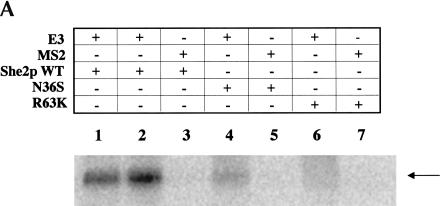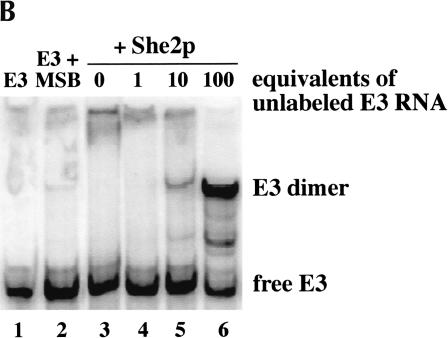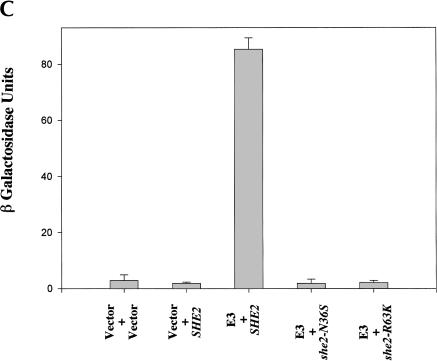FIGURE 4.
She2p mutants N36S and R63K are defective for ASH1 and IST2 mRNA-binding activity. (A) The UV cross-linking assay was performed by incubating (lane 1) 0.25 μg of GST-She2p-wt, (lanes 2,3) 0.5 μg of GST-She2p-wt, (lanes 4,5) 5.0 μg of GST-She2p-N36S, or (lanes 6,7) 5.0 μg of GST-She2p-R63K with 1 ng of (lanes 1,2,4,6) 32P-labeled E3 RNA or (lanes 3,5,7) MS2 RNA. The arrow indicates the position of the GST-She2p/RNA complex. (B) Apparent gel shift of She2p with E3 RNA is not caused by RNA–protein complex formation. (Lane 1) Trace (1 nM) labeled E3 RNA combined with (lane 2) mobility shift buffer (MSB) produces an apparent mobility shift in the absence of protein. Addition of (lanes 3–6) 125 nM She2p with (lanes 4–6) increasing molar equivalents of unlabeled E3 competitor RNA results in an increase, not a decrease, in the amount of the shifted species, and is consistent with the formation of a base-paired RNA duplex, not an RNA–protein complex. (C) She2p RNA-binding activity for mutants N36S and R63K as measured by three-hybrid assay. Strain YLM585 was transformed with the following combinations of plasmids: pIIIA-MS2–2(vector)/pGAD-c1 (vector), pIIIA-MS2-2/pRL445 (pGAD-c1-Shep-wt), pRL80 (pIIIA-MS2-2-E3)/pRL445, pRL80/pRL441 (pGAD-c1-She2p-N36S), and pRL80/pRL442 (pGAD-c1-She2p-R63K). Transformants were grown in liquid culture and processed for β-galactosidase assay. (D) She2p RNA-binding activity for She2p mutants N36S and R63K as measured by IP/RT-PCR. Yeast strain YLM777 was transformed with plasmid C3431 (YEplac195/ASH1) and plasmid (lanes 1,2) pRL199 (She2-myc6-wt), (lane 3) pRL324 (She2-myc6-N36S), or (lane 4) pRL322 (She2p-myc6-R63K). Transformants were grown in synthetic media devoid of leucine and uracil; lysates were prepared and immunoprecipitations were performed with anti-myc. Immunoprecipitations were subsequently used for RT-PCR reactions with primers specific for ASH1 mRNA or IST2 mRNA. RT-PCR reactions corresponding to an aliquot of the lysates prior to immunoprecipitation (total) are shown as well as reactions corresponding to the immunoprecipitation reactions with and without RT (+RT and −RT). Also, an aliquot of the immunoprecipitation was analyzed by Western blot using anti-myc.




